Abstract
Crack is a condition indicator of the pavement’s structure. Generally, crack detection is an essential task for effective diagnosis of the road network. Moreover, evaluation of road quality is necessary to ensure traffic security. Since 2011, a periodic survey of approximately 57,500 km of Moroccan roads has been performed using an inspection vehicle (SMAC) which is equipped with high resolution cameras and GPS/DGPS receivers. Until recently, the teams of the National Center for Road Studies and Research (CNER) analyzed road surface states by visualization of pavement surface image sequences captured by the Multifunctional Pavement Assessment System (SMAC) in order to detect defects in road surfaces and classify them according to their type. However, this method involves manual processing and is complex, time consuming and subjective. In this paper, we propose an automated methodology for crack detection and classification in Moroccan flexible pavements using Convolutional Neural Networks (CNN). Transfer learning is also applied by testing a pre-trained Visual Geometry Group 19 (VGG-19) model. For the dataset used in this paper, the results indicate that good crack detection and classification are achieved using both models.
1. Introduction
Road crack detection and crack type classification are necessary to ensure road durability, traffic security and driver safety [1]. In Morocco, roads are inspected every two years in order to plan the necessary maintenance and reconstruction efforts [2].
In the past, the detection of road defects was performed visually by specialized agents stopping every 200 m along the road and taking images in order to verify the state of road damage, classify the different types of defects present (e.g., alligator cracking, longitudinal cracking, pothole, transverse cracking) [2,3] and then determine the surface condition indicator (ISU) [2]. Such visual inspections are very time consuming, complex and risky for the inspectors. Since multi-functional road detection systems are safer and objective, the National Center for Road Studies and Research (CNER) acquired, in 2011, a road detection vehicle for the characterization of different road damage types (SMAC). The road condition recording is completed at a vehicle velocity of 100 km/h. The multifunctional pavement assessment vehicle is equipped with three front cameras and three macro cameras operating with high resolution. It also contains lighting equipment for ensuring sufficient brightness during recording at night and GPS/DGPS receivers to record the position of the vehicle [2,4].
There are many studies present in the literature describing road surface inspection systems. In 2017, Eisenbach et al., in [5], used a multifunctional road detection vehicle with an inertial navigation system, laser sensors for evenness and texture measurement, a 2D laser range finder and two cameras. A majority of literature sources report, however, less sophisticated recording equipment being used for such purposes. In many cases, a smartphone mounted on a vehicle is used to acquire the pavement surface images [6,7,8].
In Morocco, the image acquisition method for road defect detection has evolved, but the analysis of the data is still based on traditional image processing performed manually in the CNER laboratory using the image processing software “Argus” [2,4]. Since automatic image processing in the field of road infrastructure is very limited in our country, this paper proposes and evaluates a new method for automatic road crack detection using a convolutional neural network (CNN) [9]. The proposed method allows us to classify the road cracks into three classes: longitudinal, alligator type crack or no crack [1,3]. In order to demonstrate the capabilities of the proposed CNN model, the results are also compared with the classification outcome of a pre-trained transfer learning model (Visual Geometry Group 19 [10]).
In the literature, several deep learning algorithms for image processing were presented to detect road cracks [8]. In 2016, Zhang et al., in [6], proposed a method for crack detection from square image patches using ConvNets applied on a database of 500 images. Mandal et al., in [7], presented a neural network algorithm based on YOLO V2 in 2018, using images obtained from a smartphone mounted on a vehicle. In the same year, Maeda et al., in [8], demonstrated accuracies of 71% and 77% by applying MobileNet and Inception V2, respectively. In this case, an inference time of 1.5 s, by developing a large-scale image database taken by a vehicle-mounted smartphone, was used. In 2019, Fan et al., in [11], achieved 99.92% accuracy when applying a deep learning algorithm for adaptive segmentation to extract cracks from the pavement surface. In the same year, a system that uses DCNN to detect and classify the pavement crack was developed [12]. Another end-to-end CNN model called DeepCrack was applied by Zou et al. in [13]. Although the results show that DeepCrack achieved an F1 score of over 87%, the model was sensitive to crack image noise. In 2020, Weidong et al., in [14], used CrackSeg and Mei, in [15], introduced a GoPro on the back of a vehicle in order to implement the ConnCrack method, which combines Wasserstein’s adversarial network and connectivity maps. Fan et al., in [16], proposed an algorithm that uses an encoder–decoder architecture with hierarchical feature learning and dilated convolution (U-HDN), and Sheta et al., in [17], achieved an average accuracy of 97.27% working on a lightweight convolutional neural network model used in real time. Fan et al., in [18], proposed an ensemble of convolutional neural networks without a pooling layer using two public crack databases: CFD and AigleRN. The results indicated that a good crack detection from measured recording was achieved. In 2021, Fan et al., in [19], built a new RAO-UNet pavement crack detection model using an encoder–decoder and achieved better performance in processing speed and detection accuracy. In the same year, Hacıefendioğlu et al., in [20], deduced that the number of cracks detected at concrete road surfaces was independent of weather conditions during recording (sunny day and cloudy day) when they used a new approach based on fast pre-trained R-CNN.
Fan et al., in [21], proposed a deep residual convolutional neural network called Parallel ResNet for the purpose of detecting cracks at two publicly available datasets (CrackTree200 and CFD). Xu et al., in [22], developed a new network called The LETNet for crack detection in pavements, which is very effective, especially when dealing with images of cracks recorded with a lot of noise and complex lighting conditions. Xu et al., in [23], obtained good results by applying Faster R-CNN and Mask R-CNN on a database composed of only 130+ images.
Many studies presented in the literature describe powerful transfer learning algorithms for the detection and classification of road cracks, especially when a large dataset is involved (e.g., the pre-trained CNN architectures AlexNet [24,25,26], VGG-16 [27,28,29], ResNet [24,25,26] SqueezeNet [23], GoogleNet [25,26,27] and VGG-19 [10,30]).
This paper addresses the following aspects of an automated crack detection method and an example of its application for road inspection purposes:
- description of a novel inspection solution applied to Moroccan flexible pavement using a multifunctional pavement assessment system vehicle (SMAC) and deep neural networks for automatic crack detection and classification,
- application of the classification method on a large dataset extracted from videos captured by high-resolution cameras mounted on a SMAC vehicle,
- proposal and evaluation of a new method for automatic road crack detection using a convolutional neural network (CNN). The results are further compared with the outcome of a pre-trained transfer-learning VGG-19 model.
2. Dataset and Methods
2.1. Measurement and Resulting Dataset
In the proposed road crack classification approach, we used real images extracted from video frames of a video database delivered by the Moroccan National Center for Road Studies and Research (CNER) and acquired by the SMAC system. The system is equipped with three macro digital cameras with a field of view orthogonal to the road plane. For a high-definition recording of the road surface, lighting with aligned strobe lights and three front cameras are applied: one directed towards the front and two other optional cameras to film the lateral environment of the road. Figure 1 shows a rear and a front view of a vehicle equipped with the SMAC system. It is important to note that the Multifunctional Pavement Inspection System SMAC is the first high-performance equipment used in Morocco to capture surface videos of the pavement and its environment at traffic speed [2,4].
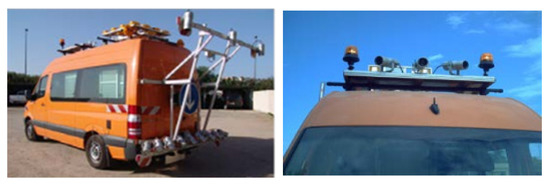
Figure 1.
Multifunctional Pavement Inspection System SMAC with macro cameras (left) and front cameras (right).
In this work, we are particularly interested in the cracks of alligator and longitudinal types, since they are the most common defects at the level of the Moroccan flexible pavements. We extracted a dataset of 3287 images which were manually labelled. The labels are divided into three classes (no crack, alligator crack and longitudinal crack), as exemplarily shown in Figure 2 and described in Table 1.
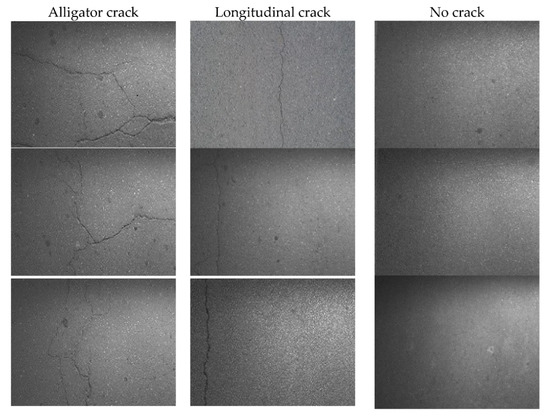
Figure 2.
Example of the three road classes.

Table 1.
Types of road cracks.
In this study, the image dataset is randomly divided into 50% of images for training, 25% for validation and 25% of the remaining image data for testing our models. The amount of images used for training, validation and testing is listed in Table 2. The performance of the proposed CNN model and the VGG-19 pre-trained model in the context of pavement crack detection and classification is evaluated using the collected, labeled and resized images (size 250 × 250 RGB).

Table 2.
Number of images used for training, validation and testing.
2.2. Convolution Neural Network
The CNN, also called ConvNet, is a deep learning algorithm first proposed in 1989 by LeCun et al. [31]. It is one of the most successful deep learning models for image classification [9].
In this work, a CNN model with an input size of 250 × 250 pixels is applied. The architecture of the model is shown in Figure 3. It is composed of seven convolutional layers, six maxpooling layers, two fully connected layers and a last softmax layer for classification. The convolutional layer is the first layer of a neural network and is considered as a relevant feature extractor. Kernels and filters of the convolutional layer scan the images to detect patterns.
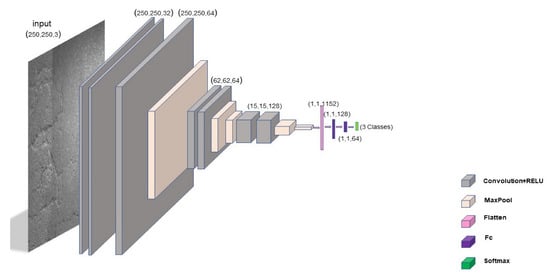
Figure 3.
The proposed convolutional neural network (CNN) architecture.
The CNN consists of 3 convolution blocks, where the first block is composed of 3 convolution layers, the first and second layer contain 32 filters of size 3 × 3 pixels and the third contains 64 filters of size 3 × 3 pixels. The three convolution layers are succeeded by two maxpooling layers of filter size 2 × 2. The second block contains 2 convolution layers with 64 filters of size 3 × 3 followed by 2 maxpooling layers with a filter of size 2 × 2. In the third block, 2 convolution layers are given with 128 filters of size 3 × 3, succeeded by 2 maxpooling layers with a filter of size 2 × 2.
We are using the activation function ReLU (Rectified Linear Unit) after each convolution. According to equation 1, ReLU replaces all negative pixel values in the feature map with 0. The application of ReLU also prevents the occurrence of the vanishing gradient problem.
The maxpooling layer is used to perform the pooling. Its purpose is to reduce the dimension of each feature map and to reduce the number of parameters and calculations in the network while keeping the important information. The dropout layer comes after the maxpooling layers to minimize the overfitting of the model. The dropout of the first and second block is 25%, and the dropout of the third block is 50%. Flatten is used to convert the feature map into one dimension (vector) for further classification. In our study, the output of the flatten layer is a one-dimensional vector of dimension 1152. Then, this vector is sent to a fully-connected network containing three dense layers. The first and second fully connected layers contain 128 and 64 neurons, respectively. The mathematical operation of the fully connected layer is defined by:
where and are the input and output vector size. is the output of the fully connected layer.represents the weights matrix, and represents the bias matrix.
The final layer contains three neurons. It uses the softmax function (Equation (3)) as an activation function for classification. As the input, it takes a vector of real values and normalizes it to a probability between 0 and 1. This is the probability for the input image to belong to one of the three classes.
2.3. Pre-Trained VGG-19 Model
The Visual Geometry Group 19 (VGG-19) transfer learning model was developed by a research team at Oxford University [10]. This model is a deep learning model and has been trained on millions of diverse images with complex classification tasks.
In this section, we propose the use of a pre-trained Deep Convolutional Neural Network (VGG19) model with transfer learning for automated pavement crack detection and classification. Using Keras in Tensorflow, we applied the pre-trained model on our database. The VGG-19 comprises 19 convolutional layers, as shown in Figure 4. It is composed of 16 convolution layers with a filter size of 3 × 3 and 5 2 × 2 pooling layers. This is followed by a fully connected layer with a filter size of 3 × 3, and a softmax layer for image classification.
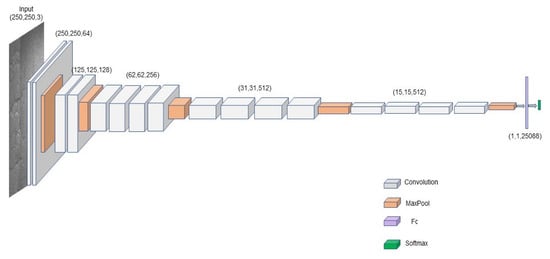
Figure 4.
Schematics of VGG-19 deep learning model architecture.
3. Results
The performance of the two deep learning models for crack detection and classification was evaluated on a database of 3287 Moroccan road images. The number of parameters for each model is listed in Table 3. The program is currently implemented in Python code.

Table 3.
Number of parameters in the used classification models.
The results confirm that the CNN model used requires a lower number of parameters compared with the VGG-19 pre-trained model. As listed in Table 3, the VGG-19 model contains a four-times higher number of parameters than the CNN. We expect that having more parameters significantly extends the classification time. Additionally, the number of parameters in the VGG-19 model strongly indicates higher complexity of the model compared with the CNN model. In this study, the number of training epochs is set to 40. A larger value of training epochs may extend the training time and lead to overfitting of the models.
Figure 5 and Figure 6 summarize the results of the training and validation of the two networks, CNN and VGG-19. The Loss function, observed during training and validation phases, measures the rate of error in the model and, therefore, the performance of the model. The VGG model converged to the minimum loss value of 10.47% at the 40th epoch, and reached the minimum loss value of the validation of 22.72% at the 32nd epoch. The lowest loss value of the proposed CNN model in training is 12.65% at the 40th epoch and, in validation, is 18.65% at epoch 34/40.
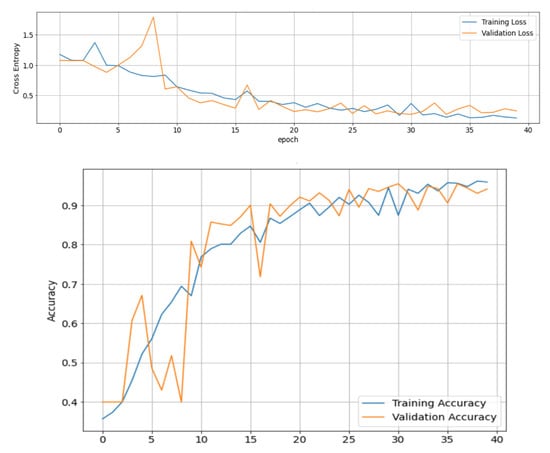
Figure 5.
Training and validation plots of the proposed CNN model: loss graph (top) and accuracy graph (bottom).
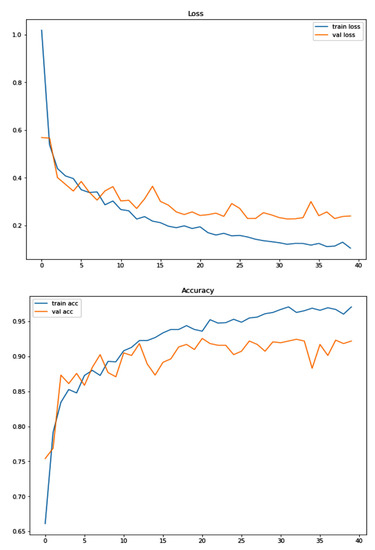
Figure 6.
Training and validation plots of the VGG-19 model: loss graph (top) and accuracy graph (bottom).
The results of our study are listed in Table 4 and Table 5. To compare the performance of the new CNN model with the VGG-19 model, a variety of evaluation metrics, such as accuracy, precision, recall and F1-score, are calculated. These measures use the notions of positive and negative. Table 4 shows the values of true positives (TP), true negatives (TN), false positives (FP) and false negatives (TN) calculated from the results of the confusion matrices obtained after testing the two models, CNN and VGG-19, shown in Figure 7.

Table 4.
Performance metrics for each class of CNN model.

Table 5.
Performance metrics for each class of VGG-19 model.

Figure 7.
The confusion matrices for testing phase: (a) CNN, (b) VGG-19.
Considering a positive class, true positive (TP) is the number of testing images that are correctly classified. True negative (TN) is the number of the negative testing images correctly classified as negatives. False positive (FP) is the number of negative images that are tested and classified as positive. False negative (FN) is the number of positive images that are classified as negative after the test.
In our study, four metrics are used for the evaluation of the proposed networks, which are: accuracy, recall, precision and F1-score. According to Equation (4), the accuracy is defined as the ratio of correctly classified images to the total number of tested images.
Recall is defined as the ratio of positive images correctly identified as positive to the total number of True positive and False negative images, as given by the following Equation (5).
Precision is the ratio of positive images correctly classified as positive to the total number of true positive and false positive according to the following relation:
Finally, the F1-score measures accuracy by using the values of precision and recall based on the following relation:
The values of precision, recall and F1-score of each class in our image dataset are listed in Table 4. It is observed that the highest F1-score value results for the no crack class are 95.58% for CNN and 94.83% for VGG-19. Both models are most accurate in detecting the no crack class. Moreover, both models are more accurate in the detection of alligator cracks than in the detection of longitudinal cracks. This finding can be explained by the lower number of images of the longitudinal crack class in the database. In our case, the CNN model performs better than the VGG model in detecting all classes.
According to the summarized results in Table 6, both models show high F1-score values. It means that both models have successfully detected and classified the images into alligator crack, longitudinal crack and no crack. The CNN model performs with an F1-score value of 93.19%, which is higher than the F1-score value of the VGG model (90.76%). The above results show that the proposed CNN network performs better than the pre-trained VGG-19 network.

Table 6.
Recall, precision and F1-score values of models used for pavement crack classification.
The results of the proposed models deliver similar performance levels as many studies presented in the literature for solving road crack detection and classification problems, such as using SVM [6], YOLO V2 [7] MobileNet and Inception V2 [8]. However, the comparison with other deep learning algorithms is partially valid due to the fact that different databases for training are used.
4. Conclusions
In this research, we have proposed a methodology for pavement image crack detection and classification utilizing an artificial neural network, particularly, convolutional neural networks applied for the classification of recordings from Moroccan pavement inspection. The performance of two models was evaluated for the detection and classification of cracks in pavement structures. We used a database of 3287 high-definition images extracted from videos captured by high-resolution cameras mounted on the SMAC vehicle. We found that the accuracy and F1-score of the CNN model are slightly higher compared with those of the VGG-19 model, while the complexity and training duration of the latter, caused by a larger network size, are significantly higher. This indicates that the crack detection and classification are more accurately achieved with the CNN model, even though it contains fewer convolution layers than the VGG-19 pre-trained model. The proposed CNN model requires a smaller number of parameters compared to the pre-trained model, resulting in better performance.
The results showed that the F1-score result of the alligator cracks, 93.45% for CNN and 89.34% for VGG-19, is larger than the results of longitudinal cracks: 88.53% for CNN and 86.24% for VGG-19. It is concluded that while the database used in this work is relatively large, a larger dataset of pavement images with a higher amount of longitudinal cracks would certainly increase the detection precision of the longitudinal crack class.
All the results indicated that the proposed CNN and pre-trained model VGG-19 can be used for automatic detection and classification in Moroccan flexible pavement. Our research also demonstrates the benefit of deep learning models in Moroccan road inspection.
In future work, we are planning to investigate the road crack classification performance of other deep learning algorithms on larger databases in order to detect and classify additional pavement damage types.
Author Contributions
Conceptualization, W.H. and C.C.; writing—original draft preparation, W.H.; methodology, W.H., G.K. and M.M. All authors have read and agreed to the published version of the manuscript.
Funding
This research received no external funding.
Data Availability Statement
Not applicable.
Conflicts of Interest
The authors declare no conflict of interest.
References
- Laboratoire Centrale des Ponts et Chaussées. LCPC Méthode D’Essai No.52. Available online: https://www.ifsttar.fr/fileadmin/user_upload/editions/lcpc/MethodeDEssai/MethodeDEssai-LCPC-ME52.pdf (accessed on 28 July 2015).
- Analyse de la Méthode Marocaine des Degradations de Chaussées. Available online: http://www.ampcr.ma/actes/9eme_congres_national_de_la_route/CONGRE/A4/A4_3.pdf (accessed on 8 October 2014).
- Modèles de Dégradation des Chaussées Marocaines. Available online: http://www.ampcr.ma/actes/7eme_congres_national_de_la_route/CONGRE/TH2/TH2_9.pdf (accessed on 25 October 2006).
- Presentation du CNER. Available online: http://www.equipement.gov.ma/AR/Infrastructures-routieres/Reseau-Routier-du-Maroc/Documents/brochure%20CNER%202019.pdf (accessed on 17 January 2020).
- Eisenbach, M.; Stricker, R.; Seichter, D.; Amende, K.; Debes, K.; Sesselmann, M.; Ebersbach, D. How to get pavement distress detection ready for deep learning? A systematic approach. In Proceedings of the IJCNN 2017, Anchorage, AK, USA, 14–19 May 2017; pp. 2039–2047. [Google Scholar]
- Zhang, L.; Yang, F.; Zhang, D.Y.; Zhu, J.Y. Road crack detection using deep convolutional neural network. In Proceedings of the IEEE International Conference on Image Processing (ICIP), Philadelphia, PA, USA, 25–28 September 2016; pp. 3708–3712. [Google Scholar]
- Mandal, V.; Uong, L.; Adu-Gyamfi, Y. Automated road crack detection using deep convolutional neural networks. In Proceedings of the IEEE International Conference on Big Data (Big Data), Seattle, WA, USA, 10–13 December 2018; pp. 5212–5215. [Google Scholar]
- Maeda, H.; Sekimoto, Y.; Seto, T.; Kashiyama, T.; Omata, H. Road damage detection and classification using deep neural networks with smartphone images. Comput.-Aided Civ. Infrastruct. Eng. 2018, 1–15, 1127–1141. [Google Scholar] [CrossRef]
- Introduction to Convolutional Neural Networks. Available online: https://cs.nju.edu.cn/wujx/paper/CNN.pdf (accessed on 30 April 2017).
- Simonyan, K.; Zisserman, A. Very deep convolutional networks for large-scale image recognition. In Proceedings of the ICLR, San Diego, CA, USA, 7–9 May 2015. [Google Scholar]
- Fan, R.; Bocus, J.M.; Zhu, Y.; Jianhao, J.; Wang, L.; Fulong, M.; Shanshan, C.; Ming, L. Road crack detection using deep convolutional neural network and adaptative thresholding. In Proceedings of the IEEE Intelligent Vehicules Symposium, Paris, France, 9–12 June 2019; pp. 474–479. [Google Scholar]
- Yusof, N.A.M.; Osman, M.K.; Noor, M.H.M.; Ibrahim, A.; Tahir, N.M.; Yusof, N.M. Crack detection and classification in asphalt pavement images using deep convolution neural network. In Proceedings of the 8th IEEE International Conference on Control System, Computing and Engineering (ICCSCE), Penang, Malaysia, 23–25 November 2018; pp. 227–232. [Google Scholar]
- Zou, Q.; Zhang, Z.; Li, Q.; Qi, X.; Wang, Q.; Wang, S. Deep Crack: Learning hierarchical convolutional features for crack detection. IEEE Trans. Image Process. 2019, 28, 1498–1512. [Google Scholar] [CrossRef] [PubMed]
- Weidong, S.; Guohui, J.; Hong, Z.; Di, J.; Lin, G. Automated pavement crack damage detection using deep multiscale convolutional features. J. Adv. Transp. 2020, 2020, 1–11. [Google Scholar]
- Mei, Q.; Gül, M. A cost effective solution for pavement crack inspection using cameras and deep neural networks. Constr. Build. Mater. 2020, 256, 119397. [Google Scholar] [CrossRef]
- Fan, Z.; Li, C.; Chen, Y.; Wei, J.; Loprencipe, G.; Chen, X.; DiMascio, P. Automatic crack detection on road Pavements Using Encoder-Decoder Architecture. Materials 2020, 13, 2960. [Google Scholar] [CrossRef] [PubMed]
- Sheta, A.; Turabieh, H.; Aljahdali, S.; Alangari, A. Pavement crack detection using a lightweight convolutional neural network. EPIC Ser. Comput. 2020, 69, 214–223. [Google Scholar]
- Fan, Z.; Li, C.; Chen, Y.; Mascio, P.D.; Chen, X.; Zhu, G.; Loprencipe, G. Ensemble of Deep Convolutional Neural Networks for Automatic Pavement Crack Detection and Measurement. Coatings 2020, 10, 152. [Google Scholar] [CrossRef]
- Fan, L.; Zhao, H.; Li, Y.; Li, S.; Zhou, R.; Chu, W. Rao-Unet: A residual attention and octave Unet for road crack detection via balance loss. IET Intell. Transp. Syst. 2021, 16, 332–343. [Google Scholar] [CrossRef]
- Haciefendioglu, K.; Basaga, H.B. Concrete road crack detection using deep learning-based faster R-CNN method. Ir. J. Sc. Techn. Transact. Civ. Eng. 2021, 46, 1621–1633. [Google Scholar] [CrossRef]
- Fan, Z.; Lin, H.; Li, C.; Su, J.; Li, C.; Bruno, S.; Loprencipe, G. Use of Parallel ResNet for High-Performance Pavement Crack Detection and Measurement. Sustainability 2022, 14, 1825. [Google Scholar] [CrossRef]
- Xu, Z.; Guan, H.; Kang, J.; Lei, X.; Ma, L.; Yu, Y.; Chen, Y.; Li, J. Pavement crack detection from CCD images with a locally enhanced transformer network. Int. J. Appl. Earth Observat. Geoinformat. 2022, 110, 102825. [Google Scholar] [CrossRef]
- Xu, X.; Zhao, M.; Shi, P.; Ren, R.; He, X.; Wei, X.; Yang, H. Crack Detection and Comparison Study Based on Faster R-CNN and Mask R-CNN. Sensors 2022, 22, 1215. [Google Scholar] [CrossRef] [PubMed]
- Ullah, A.; Elahi, H.; Sun, Z.; Khatoon, A.; Ahmad, I. Comparative Analysis of AlexNet, ResNet18 and SqueezeNet with Diverse Modification and Arduous Implementation. Arab J. Sci. Eng. 2022, 47, 2397–2417. [Google Scholar] [CrossRef]
- Jana, S.; Thangam, S.; Kishore, A.; Kumar, V.S.; Vandana, S. Transfer learning based deep convolutional neural network model for pavement crack detection from images. Int. J. Nonlinear Anal. Applicat. 2022, 13, 1209–1223. [Google Scholar]
- Khan, M.N.; Ahmed, M.M. Weather and surface condition detection based on road-side webcams: Application of pre-trained convolutional neural network. Int. J. Transport. Sci. Technol. 2021, 11, 468–483. [Google Scholar] [CrossRef]
- Munawar, H.S.; Hammad, A.W.A.; Haddad, A.; Soares, C.A.P.; Waller, S.T. Image-Based Crack Detection Methods: A Review. Infrastructures 2021, 6, 115. [Google Scholar] [CrossRef]
- Qu, Z.; Mei, J.; Liu, L.; Zhou, D. Crack Detection of Concrete Pavement with Cross-Entropy Loss Function and Improved VGG16 Network Model. IEEE Access 2020, 8, 54564–54573. [Google Scholar] [CrossRef]
- Dung, C.V.; Anh, L.D. Autonomous concrete crack detection using deep fully convolutional neural network. Autom. Construct. 2019, 99, 52–58. [Google Scholar] [CrossRef]
- Samma, H.; Suandi, A.S.; Ismail, N.A.; Sulaiman, S. Evolving Pre-Trained CNN Using Two-Layers Optimizer for Road Damage Detection from Drone Images. IEEE Access 2021, 9, 158215–158226. [Google Scholar] [CrossRef]
- LeCun, Y.; Boser, B.; Denker, J.S.; Henderson, D.; Howard, R.E.; Hubbard, W.; Jackel, L.D. Backpropagation applied to handwritten zip code recognition. Neural Comput. 1989, 1, 541–551. [Google Scholar] [CrossRef]
Publisher’s Note: MDPI stays neutral with regard to jurisdictional claims in published maps and institutional affiliations. |
© 2022 by the authors. Licensee MDPI, Basel, Switzerland. This article is an open access article distributed under the terms and conditions of the Creative Commons Attribution (CC BY) license (https://creativecommons.org/licenses/by/4.0/).